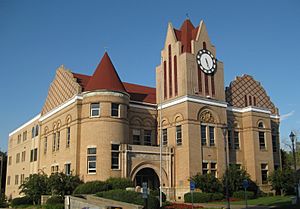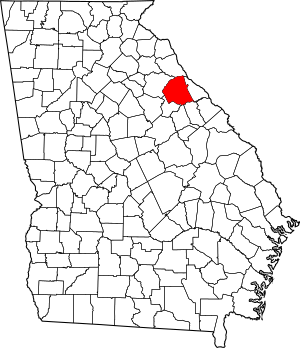Wilkes County, Georgia facts for kids
Quick facts for kids
Wilkes County
|
|
|---|---|

|
|

Location within the U.S. state of Georgia
|
|
 Georgia's location within the U.S. |
|
| Country | |
| State | |
| Founded | February 5, 1777 |
| Named for | John Wilkes |
| Seat | Washington |
| Largest city | Washington |
| Area | |
| • Total | 474 sq mi (1,230 km2) |
| • Land | 469 sq mi (1,210 km2) |
| • Water | 4.6 sq mi (12 km2) 1.0%% |
| Population
(2020)
|
|
| • Total | 9,565 |
| • Density | 20/sq mi (8/km2) |
| Time zone | UTC−5 (Eastern) |
| • Summer (DST) | UTC−4 (EDT) |
| Congressional districts | 10th, 12th |
Wilkes County is a county located in the east central part of Georgia. In 2020, about 9,565 people lived there. The main city and county seat is Washington.
People often call the area "Washington-Wilkes" because the city and county are closely linked. This county is part of the Central Savannah River Area (CSRA).
Contents
Discovering Wilkes County's Past
Wilkes County was named after John Wilkes, a British politician who supported American independence. It was the very first county in Georgia created by European Americans. It was officially formed on February 5, 1777. Seven other counties were also created around the same time.
How Wilkes County Was Formed
Wilkes County was special because its land came from agreements with the Creek and Cherokee Native American nations in 1773. Its location was also unique, being close to the Atlantic seaboard fall line.
Over many years, from 1790 to 1854, Wilkes County became smaller. As more people moved into the area, new counties were created from parts of Wilkes County. These new counties included Elbert, Oglethorpe, and Lincoln. Parts of Wilkes also helped form Madison, Warren, Taliaferro, Hart, McDuffie, and Greene Counties.
Revolutionary War Victory
Wilkes County was the site of an important battle during the American Revolutionary War in Georgia. In 1779, American forces won a big victory over British supporters at the Battle of Kettle Creek.
The Cotton Gin's Impact
In the 1700s and 1800s, many farms in this area used enslaved African American workers. These workers cleared land and grew crops like cotton. Before 1793, it was very hard to make money from growing a certain type of cotton called short-staple cotton.
But in 1793, an American named Eli Whitney invented the cotton gin. He perfected it at a cotton farm near Washington. This machine made it much easier to process short-staple cotton. Because of this invention, growing cotton became very profitable. This led to a huge increase in cotton farms across the Deep South.
Changes for Native Americans
As cotton farming grew, more settlers wanted land. This put pressure on the government to move Native Americans from their traditional lands. In 1794, a Revolutionary War veteran named Elijah Clarke led a group from Wilkes County into Creek lands. They tried to set up their own area called the Trans-Oconee Republic.
Later, in 1830, the government passed the Indian Removal Act. This law forced many Native American tribes, including the Five Civilized Tribes, to move far away to lands west of the Mississippi River.
Wealth and Conflict
The growth of cotton farming, often called "King Cotton," brought a lot of wealth to many plantation owners before the American Civil War. However, it also greatly increased the demand for enslaved workers. This led to a sad trade where over a million enslaved people were forced to move from the Upper South to the Deep South.
Wilkes County During the Civil War
No major battles of the American Civil War were fought in Wilkes County. However, it was a very important place at the end of the war. Jefferson Davis, who was the President of the Confederate States of America, had his final meeting with his government here. They officially ended the Confederate government in Wilkes County.
It's also rumored that the last known location of the Confederate gold was in Wilkes County. Today, the Wilkes County Courthouse in Washington stands where that final meeting took place.
Exploring Wilkes County's Geography
Wilkes County covers about 474 square miles. Most of this area, about 469 square miles, is land. The rest, about 4.6 square miles, is water. The county is located in the Piedmont region, which is above the fall line.
Rivers and Waterways
The northern part of Wilkes County is in the Broad River area, which flows into the Savannah River. The eastern part of the county, including Washington, is in the Upper Savannah River area. The southern part of the county is in the Little River area, which also flows into the Savannah River.
Main Roads in Wilkes County
Neighboring Counties
Wilkes County shares borders with these other counties:
- Elbert County (north)
- Lincoln County (east)
- McDuffie County (southeast)
- Warren County (south)
- Taliaferro County (southwest)
- Oglethorpe County (west)
Communities in Wilkes County
City
- Washington (This is the county seat, meaning it's the main administrative city.)
Towns
Population Changes in Wilkes County
Over the years, the number of people living in Wilkes County has changed a lot. After 1930, the population started to go down. This was due to changes in farming, a tough economic time called the Great Depression, and a large movement of African Americans away from the area in the mid-20th century.
In 2020, there were 9,565 people living in Wilkes County. About 51.77% of the people were White, and about 40.13% were Black or African American.
Famous People from Wilkes County
Many interesting people have come from Wilkes County, including:
- Edward Porter Alexander
- Eliza Frances Andrews
- Benjamin F. Bryant, a brave captain and Texas Ranger
- John Clark, a former governor of Georgia
- Elijah Clarke, a Revolutionary War veteran
- Peter Early
- Frank Edwards, a blues musician
- Stephen Heard
- Hosea Hudson, a Black labor organizer and author
- George Mathews, a military officer and governor
- Jesse Mercer
- David Meriwether, a military officer and politician
- Paul Jones Semmes
- Alexander H. Stephens
- Matthew Talbot
- Benjamin Taliaferro
- Robert Toombs
- George W. Towns
See also
 In Spanish: Condado de Wilkes (Georgia) para niños
In Spanish: Condado de Wilkes (Georgia) para niños

